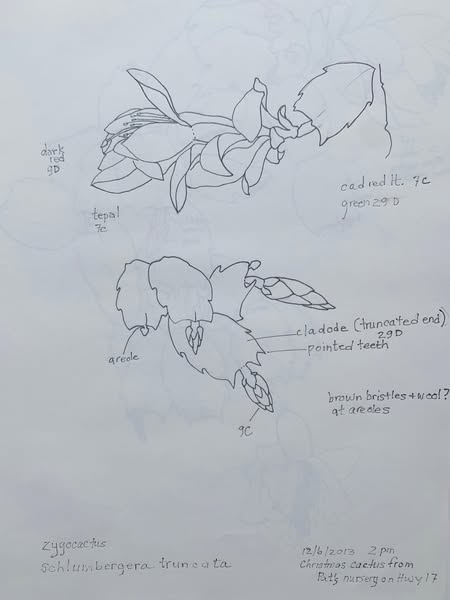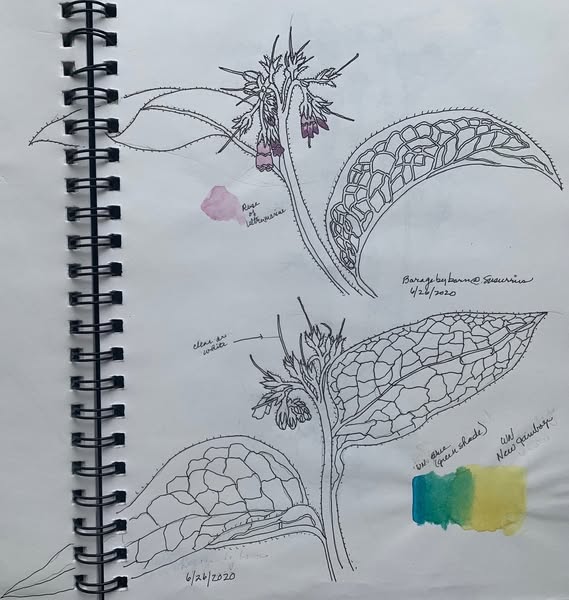This past week the American Society of Botanical Artists held their online spring conference. It was a pleasure to sit comfortably in my living room and watch very talented botanical artists from many different parts of the world talk about their painting processes.
Because plants are important to people for food as well as beauty, botanical painting has become an important topic to people everywhere in the world. While art supplies may be expensive, they do not need to be pricey, so artists can create beautiful works of art with a minimum of expense.
Children can also learn to express themselves using simple paints and can enjoy looking at the details of plants carefully. Children love to collect specimens, whether they are picking dandelions and examining the petals and leaves in the spring or finding little brown-capped acorns in the fall.
Lucy T. Smith and Giacomina Ferrino each talked about the sketchbook as an important part of the process of becoming a strong botanical artist. Lucy Smith talked about her bottles of little objects and drawers with “bits and pieces stacked away.” She emptied out her whimsical collection of seed pods onto her sketchbook. Her sketchbooks are a place where she relaxes with her drawing and experiments with composition.
Most of her sketches were completed with pencil and pens. She uses 2H and HB pencils and grey and black pens sized 0.03-0.1mm. She likes to enhance the white with a “Gelly Roll” white pen size 05. Her 9 x 12” Strathore 400 series sketchbook is easy to carry. Her second preference is a Fabriano “Venezia” drawing paper sketchbook.
Giacomina Ferrino considers her sketchbook an important part of her growth as an artist as well as a source of creative expression. For commissioned work, she may start using her sketchbook to work with color and composition possibilities. It is also a way to see and perfect the detail important in a final painting.
She does not use spiral notebooks, but prefers bound books of cold pressed cotton paper. Many of her pieces are completed with watercolor over ink.
Ferrino uses a mechanical pencil at o.35 or 2.0mm or a traditional HB pencil. She also uses fine liner ink pens in black, sepia or gray 003 or 005 sizes. Micron, Unpin or Comic are her choices, she says.
Both these artists work in their sketchbooks primarily in their studios. It does not seem to be their intention to sit precariously on a camp stool recording all the details of their plant before returning to the studio to make the final painting. Rather, they seem to prefer to either collect or photograph their subjects, and then return to a comfortable place where their tools are easily available.
Personally, I also prefer the comfort of my studio to the discomfort of a camp chair. However, I do use my cell phone camera liberally and return often to check out details of a plant that is too rare to cut and bring inside.

That was the case last summer when I found a white fringed orchid along my walking trail. I had never seen it before, and hope it will return again this year. My experience with fringed orchids in northern Wisconsin, is that they only sometimes reappear the next year, and often they never reappear in the same place. They also have a rather short blooming time, so it is important to be prompt with a drawing, especially if you need to check details. For this purpose, sketchbooks are very valuable.
Usually I use the same technique as these artists for my sketchbook. Pencil, pen and then color. I have discovered that the mechanical pencils for sale in local retail stores and marked with the size of the graphite, are usually very adequate for drawing. It saves on carrying a sharpener for your pencils and saves time that is taken sharpening each pencil.
I may just put a color swatch on the paper, instead of painting in the lines. For me color is one of the most difficult things to store accurately in my brain over time. Sometimes I may use colored pencil or I may use watercolor, but the color changes as a flower ages, so it is important to get an accurate color right away. The leaves are important, too, so I may make color swatches for the top and underside of the leaves or anything else where the color will be an important reference. I always record the date and time of day when I draw from life outside.
As the air warms toward spring, this is a good time to collect your tools. All you really need is a notebook with acid free paper, 2 or 3 pencils, a small sharpener (or not) , an eraser, 2 or 3 pens and your camera or smart phone. If you want to carry color, you will need a small paint box , a brush and water. If you have drinking water on your walk, save some of that water for mixing paint.
Enjoy the birds as you walk along. Turn on your Merlin App to identify which kinds of birds are returning. Look carefully on the ground to see what is sending up new leaves. Check the expanding buds on the trees. Take in the air, the sun and everything else that brings you joy along the way.


